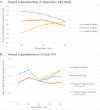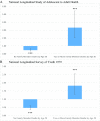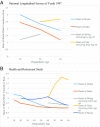Death of family members as an overlooked source of racial disadvantage in the United States
- PMID: 28115712
- PMCID: PMC5293066
- DOI: 10.1073/pnas.1605599114
Death of family members as an overlooked source of racial disadvantage in the United States
Abstract
Long-standing racial differences in US life expectancy suggest that black Americans would be exposed to significantly more family member deaths than white Americans from childhood through adulthood, which, given the health risks posed by grief and bereavement, would add to the disadvantages that they face. We analyze nationally representative US data from the National Longitudinal Study of Youth (n = 7,617) and the Health and Retirement Study (n = 34,757) to estimate racial differences in exposure to the death of family members at different ages, beginning in childhood. Results indicate that blacks are significantly more likely than whites to have experienced the death of a mother, a father, and a sibling from childhood through midlife. From young adulthood through later life, blacks are also more likely than whites to have experienced the death of a child and of a spouse. These results reveal an underappreciated layer of racial inequality in the United States, one that could contribute to the intergenerational transmission of health disadvantage. By calling attention to this heightened vulnerability of black Americans, our findings underscore the need to address the potential impact of more frequent and earlier exposure to family member deaths in the process of cumulative disadvantage.
Keywords: bereavement; disparities; family; life expectancy; race.
Conflict of interest statement
The authors declare no conflict of interest.
Figures








Comment in
-
Why death haunts black lives.Proc Natl Acad Sci U S A. 2017 Jan 31;114(5):800-802. doi: 10.1073/pnas.1620083114. Epub 2017 Jan 23. Proc Natl Acad Sci U S A. 2017. PMID: 28115702 Free PMC article. No abstract available.
References
-
- Kochanek KD, Arias E, Anderson RN. NCHS Brief. National Center for Health Statistics; Hyatsville, MD: 2013. How did cause of death contribute to race differences in life expectancy in the United States in 2010? - PubMed
-
- Williams DR, Jackson PB. Social sources of racial disparities in health. Health Aff (Millwood) 2005;24(2):325–334. - PubMed
-
- Stroebe M, Schut H, Stroebe W. Health outcomes of bereavement. Lancet. 2007;370(9603):1960–1973. - PubMed
Publication types
MeSH terms
Grants and funding
LinkOut - more resources
Full Text Sources
Other Literature Sources
Medical

